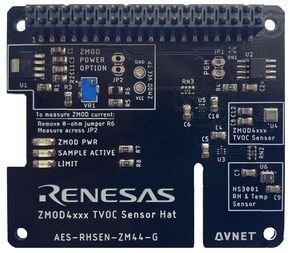There's a new Pi Hat that has been launched by Avnet that I want to tell you about. It uses a Renesas ZMOD4410 Indoor Air Quality Sensor. Since I am planning to roadtest it, I wanted to introduce it to you and see what you think. Let me give you some facts about this relatively new Pi Hat.
This Indoor Air Quality Pi HAT is an evaluation, development and quick-prototyping tool that features an on-board calibrated ZMOD4410 sensor that measures the concentrations of Total Volatile Organic Compounds (TVOC) and can estimate carbon dioxide (eCO2) levels. These are important indicators for monitoring indoor air quality. In addition to the indoor air quality sensor, the HAT incorporates a Renesas HS3001 Precision Relative Humidity and Temperature Sensor, along with software-controlled status LEDs.
To validate the HAT’s operation and begin measuring TVOC and eCO2 “out of the box” with a Raspberry Pi solution, Avnet provides a pre-compiled test application built with those algorithm libraries that runs under the Raspberry Pi operating system (formerly Raspbian).
Other nice to know facts about this Pi Hat:
- Detects a wide range of TVOC, from parts-per-billion to parts-per-million and provides eCO2 levels
- Sensors are chemically tested and factory calibrated
- On-board user-adjustable power supply option and current measurement connection points
- Configurable alarm/interrupt output
- Supplied with pre-compiled Raspberry Pi OS test/validation application
- Renesas offers licensed downloadable compiled code, enabling a product road map of indoor air measurement innovation
To learn more about the Renesas ZMOD4410 Indoor Air Quality Sensor, click here.
So, what do you think? What would you do with this Pi Hat?
Feel free to leave a comment below.







